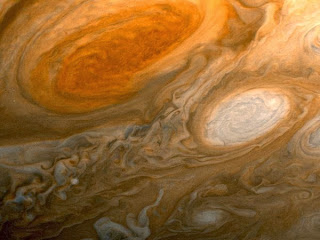Jupiter!
Hello everyone, and welcome to... Meapz4Science! Today we will be talking about the biggest planet in our solar system. We will talk about... Jupiter! We will talk about all its REALLY cool facts Jupiter has to offer.
Alright, first we will talk abut how Jupiter got its name. Jupiter was given its name by the Roman who named it after the King of the gods (because they thought of it as the king of the planets) and also the Roman god of sky and thunder. Jupiter the god is sort of similar to the Greek god Zeus.
Now we will talk about some of the things that makes it a really cool planet. To help me I have Science Cat! "Hello, Emma The Meap! I would be happy to help you instruct people about the gassiest giant in our solar system!" Okay then! First we will talk about its atmosphere. See all those swirling gases on Jupiter? That is really its atmosphere. "It gets extra points for being really pretty." Okay, Science Cat! I know you like Jupiter, but stick to the facts! "It is a fact that it's pretty!" Ugh. Anyways, the atmosphere contains of mostly hydrogen and helium. "Does that sound familiar? Could you have heard that when we talked about stars?" You are correct, Science Cat! Some also think that Jupiter has liquid on its surface and a solid core.
Jupiter has 63 known moons! "Four was just enough for people of Galileo's time. He was the person to discover four moons." Those are Europa, Io, Ganymede, and Callisto. "Some interesting facts about Europa..." I was getting to that. Europa might possibly have life on it. Why would that be, Science Cat? " Europa has ICE on it. Ice is made of frozen water! therefore, there might be water underneath the ice, containing LIFE!" Thank you, Science Cat! Next we will talk about the thing that makes Jupiter unique.
Next, we will talk about The Great Red Spot! "What is the Great Red Spot?" The Great Red Spot is actually a GIANT storm raging in Jupiter's atmosphere. You can fit THREE Earths in the Spot comfortably. "It is basically like a giant hurricane." It has also been around for at least 300 years- " because that's when the first person noticed the Spot up there." Thank you for INTERRUPTING me! Oh well. Moving on!
Now, here are five fun facts about Jupiter:
1) A day on Jupiter is 9.9 hours long.
2) Ganymede, one of Jupiter's moons, is larger than Mercury.
3) Jupiter has a diameter equivalent to 11 Earths.
4) Jupiter is bigger than all the planets except Saturn combined.
5) Io, another moon, has the most volcanic activity than any other object in the Solar System.
I hope you all enjoyed my post. I'm Emma the Meap, and I will see you next time. PEACE!!!





















































